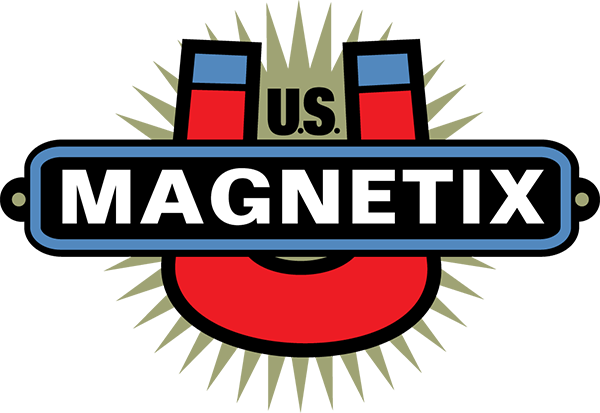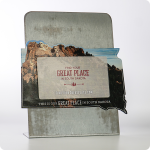Rotary Die Cutting VS Flatbed & Laser Cutting
Our rotary converting equipment is state of the art. It can handle anything from simple magnet projects to crazily complicated die-cuts and lamination for projects including brochures, ID name tags and more. We can design and create it all. But it’s not the only method of die cutting. Read on to learn how it stacks up against other methods.
Different Types of Die Cutting
There are three main die cutting production methods: Rotary Die Cutting, Flatbed Die Cutting and Laser Cutting. Planning for the right production method early on will help you avoid poor quality and wasted expenses. So, let’s look at the differences between each so you can make the best decision for your project.
Rotary Die Cutting
Rotary die cutting uses a cylindrical die, fitted with blades or creasing lines, to cut shapes out of flexible materials moving in a circular motion. The die rotates as the material is fed through the machine, kind of like a cookie cutter on a rolling pin.
Benefits of Rotary Die Cutting
Rotary die cutting allows multiple and continuous shapes to be cut quickly from material rolls, providing high-speed, accurate cutting of large volume, identical shapes. Benefits include:
- Precision: The rotary motion and precise alignment of the cylindrical die ensures accurate, identical cuts and perforations.
- Speed: Rotary die cutting is faster compared to the other die-cutting techniques.
- High Volume: Since most of the cost is associated with creating the die, rotary die cutting can be extremely cost-effective for the production of large quantities of identical parts.
Disadvantages of Rotary Die Cutting
While an excellent choice for many projects, rotary die-cutting has a few drawbacks when compared to the other cutting methods.
- Materials: The most significant limitation when it comes to rotary die-cutting is the materials it’s able to convert. Materials must be thin, flexible and on roll, which eliminates thick foam or stiff, multi-layer laminations.
- Cost: Although cost-effective for high volume production, the up-front costs associated with rotary die-cutting can be higher than those for flatbed or laser die-cutting.
Flatbed Die Cutting
Arguably the most basic method of die cutting material, flatbed die cutting uses a hydraulic press to push a steel rule die with sharp, curved blades, down onto the material, kind of like a cookie cutter.
Benefits of Flatbed Die Cutting
Flatbed die cutting is the method of choice for many projects. It can cut thick material in a sheeted form. The die can be changed out quickly and easily making it ideal for low-volume projects. Other benefits include:
- Versatility: Flatbed die cutting can be used on a wide variety of materials and for a wide range of applications from cutting gaskets to creating labels.
- Cost-effective: It can be a cost-effective option for low-volume projects or when working with thicker materials.
Disadvantages of Flatbed Die Cutting
While an excellent choice for many projects, flatbed die-cutting does have a few drawbacks when compared to the other cutting methods.
- Speed: Compared to rotary die cutting, flatbed die cutting can be slower.
- Limited Precision: While flatbed cutting creates clean and accurate cuts, it does not offer the same level or precision and uniformity as rotary die cutting.
Laser Cutting
In place of a steel rule die, laser cutting sears material using a high-powered laser beam. So technically, it is not a method of die cutting as there is no die, but it is still often compared to the other two methods as a product option, so we’ve included it here as well. The heat from the laser causes the material to melt, vaporize or burn, leaving behind a clean, precise cut.
Benefits of Laser Cutting
Since laser cutting uses a high-speed laser to cut it does not require actual contact with the material. It is also highly accurate, even with the tiniest of details. Benefits include:
- High Precision: The high-speed laser is extremely precise, allowing for tiny, intricate details to be cut accurately. Rotary and flatbed die cutting are limited by how close blades can be placed together.
- Upfront Cost: It cost less to set up a laser cut than to have a die manufactured, so the upfront cost is lower with laser cutting making it an ideal choice for a quick prototype. However if a high volume is required, it may not continue to be the most cost effective option.
- Materials: Laser cutting can be used on a variety of materials such as wood, metal and plastic, including some that would be damaged by traditional die cutting methods.
Disadvantages of Laser Cutting
While a solid choice for many projects, there are times when laser cutting doesn’t measure up to traditional die cutting.
- Speed: Laser cutting is not fast as the laser needs to adjust and follow its cutting shape.
- Clean Cut: While precise, the cut is not as clean. The high-intensity laser beam tends to leaves behind some of the melted or burned material on the edge of the cut.
- Materials: While it can be used on materials that don’t work for rotary die cutting or flatbed, it can also destroy materials and adhesives that those methods can cut. Generally, it isn’t as effective cutting thicker materials either.
The Right Die Cutting Method for Your Project
Each cutting method has it’s own set of advantages and disadvantages. The method that is best for your project will greatly depend on the material you are using and your desired quantity and quality.
If you are interested in learning more about our rotary die cutting capabilities to find out if it’s right for your project, reach out today. We are able to die-cut and laminate complex and intricate projects quickly, efficiently handle everything from one-off R & D projects to high volume production runs. Contact US Magnetix today for more information on our rotary converting and die-cutting services.


